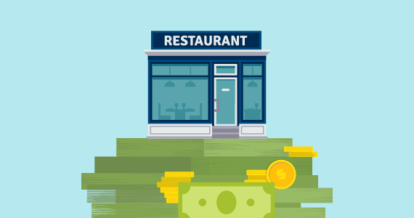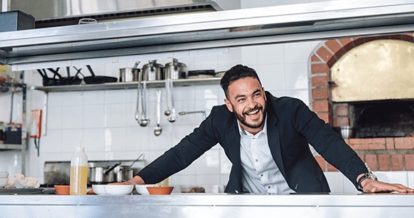So you’ve chosen to open a restaurant and you’re eager to learn how to navigate the difficult and costly dance between creating something unique yet economical.
It’s all about having the right strategy, of course. According to a recent New York Times report, “Whether a restaurant opens in hyper-competitive Manhattan or in California’s gold-rush dining scene, it has to make the same equation work: The costs of real estate, labor and food should add up to about 75 percent of its projected sales, leaving a profit margin of roughly 10 percent once smaller expenses are figured in.”
This doesn’t include the expanse of overhead costs, of which there are plenty. And it’s usually miscalculation in the early phase of opening that sets a restaurant up for failure. It’s easy to underestimate start up costs and overextend when there’s not yet any revenue to offset expenses.
Thus, essential to success is getting started on the right foot. In this post, we answer your most pertinent questions about restaurant startup costs.
Rent
How much should I pay for rent?
While the New York Times reported that New York restaurants should pay approximately 10% of revenue on rent, other sources stipulate that a lease will cost more than 5 to 8 percent of the restaurant’s total revenues. “[A] restaurant with $800,000 in sales should expect to pay $40,000 to $64,000 a year.” Other occupancy costs do apply, of course, but we’ve covered those line items in the permits section below.
Hot cash saving tip: Don’t get hung up on a look. Find a space needing as little renovations as possible and work your brand magic within it.
Equipment
How can I budget for equipment?
Everything from the spatulas to the griddles must be accounted for. According to an age-old Forbes article, ovens, ranges refrigerators, fryers, freezers and bar glass cleaners can cost anywhere between $100,000 to $300,000 and upwards. Take inflation into consideration and you’re looking at one pricey kitchen. Then there’s the thousands of little items you won’t initially think of that also need to be worked into the budget: pots, pans, storage containers, dishes, cutlery, glassware, thermometers and more. The best way to break this down is to create an extensive list of all items, then break down nice-to-haves versus must-haves. The goal here is to grow your kitchen equipment by priority as your restaurant grows.
Hot cash saving tip: Buy what you absolutely need wholesale, lease expensive equipment and as you’re starting out buy only what you need. For plates, glassware and other breakables, buy commercial products – they’re more durable and will survive repetitive use.
Technology
What technology is worth investing in?
Your POS might be the most important technology decision you make. As the main means of sales tracking and communication between the customer to the server to the bar and kitchen, choosing a POS that’s cost effective, scalable, and contains all the capabilities you need is essential to the success of your operations from all angles. An ineffective POS system will cause errors (which is not good for first customer impressions) and weigh down management as they try to get staff trained.
Hot cash saving tip: A modern POS is so intuitive it hardly requires training. What’s more? It installs easy, is fairly priced, highly scalable, and can save you money in the long run with robust reporting functions.
Renovations & Decor
What’s the best way to budget for renovations and decor?
If you’ve ever watched a home renovation show, or gone through your own renovations, you know that construction costs are almost never as quoted. As Anahi Angelone, owner of New York’s Corner Social reminds us, “When you’re building, you never know what you’ll find behind a wall. That little change can cost you $10,000.” Similarly, leaks, electric complications, and other surprises might arise that you have to contend with and/or pay for. Of course, having to convert a blank space into a kitchen and restaurant will require significant more renovation investment than working with a space already designed for a restaurant. So renovation budgets will differ greatly depending on the kind of space you go for.
As far as decorating, RestaurantEngine urges us not to forget about the cost of decor: chairs, tables, dressings, light fixtures, linens, and art deco, “Startups would do well to remember their average meal price and spend accordingly on decorating. The trick is to make dramatic statements without overspending. Search sites like Pinterest for decorating ideas on a budget.”
Hot cash saving tip: For uncomplicated installations where you can, buy raw materials and hire a contractor to install them. Also, if your budget is tight, if it ain’t broke don’t fix it. Spend your precious budget on the items that are broken first.
Food & Beverage Expenses
What about my food and beverage expenses?
There are many factors that contribute to how much of your start up budget goes into food costs like your food suppliers and your menu. Until you have the numbers to create forecasts, your first month will be a lot of “going with the flow.” Some say a good way to mitigate costs is to have vendors send weekly prices, but others negate this strategy but it’s no recipe for consistency. With smaller local suppliers you’ll be able to build a rapport and a relationship that lends itself to promotional pricing and savings.
Hot cash saving tip: As Chef Chris Dupont says, “Ultimately, you’ll be graded on the food. Diners do not come back because you put in a $600,000 kitchen – they’re coming to eat the food.”
Staff Salaries
How much budget should I allocate to staff salaries?
In a 2014 report by Baker Tilly, a full-service restaurant is looking at a spend between 30 percent and 35 percent of gross sales to payroll. A limited service restaurant would spend between 25 percent and 30 percent on payroll. And for any restaurant, management salaries should be 10 percent of sales or less.
Insurance
What insurance will I need?
There’s no one size fits all number for insurance costs, as every city has its own smorgasbord of requirements, and the final number is affected by the location, square footage, and the number of employees. Often, restaurants will have to put down deposits for each insurance policy — these add up quickly due to the varied types of restaurant insurance needed. These include: property insurance, general liability, general risk insurance, liquor liability, workers compensation, unemployment insurance, life insurance, fire insurance, loss of business insurance, and food contamination insurance. Be sure to check with your lawyer and city requirements to make sure you obtain all of the ones required.
Licenses & Permits
How much do licenses, permits and state/city requirements cost?
Restaurateurs are subject to a number of permits and licenses, many of which come with their own nominal fees. For example, New York’s Food Service Establishment Permit can cost upwards of $280, whereas Toronto’s Food Handler certification requires enrollment in a course and a passing exam and costs about $60.
Other certificates, licenses and permits may include: Food Protection Certificate, Food Service Establishment Permit, Electrical Permit, Liquor Sales and Events permit, Gas Authorization–Restaurant Equipment, Portable Fire Extinguisher Requirements, Grease Interceptor Information, Range Hoods, Recycling and Waste Removal, Required Posters and Signs (hand washing, no smoking, recycle, etc), and Resuscitation Equipment for Restaurants. Again, to be absolutely sure that you are compliant, check with your local city hall or lawyer.
Marketing & Advertising
What are cost effective ways to account for sales, marketing, advertising and design?
“Build it and they will come”, works in many circumstances, but rarely for restaurants. Of course, there’s the odd exception, but with so much competition, it’s best to spread the word before you open your doors to generate some buzz. Your essential marketing costs will be menu development and your website which will cost anywhere from a couple hundred dollars for a freelance professional or helpful friend into the thousands for a professional design firm. Non-essential, but extraordinarily helpful costs will be side-walk signage (there’s a huge ROI in a chalk board!), coupons, advertorials, and social media advertising. Of course, media nights and other guerrilla marketing incentives work well too.
Hot cash saving tip: Social media is a gold mine when used effectively and is an extraordinary way to get your business out there, for cheap. Make sure that you are active on any social media channels you sign up for and that all of your business information is correct.
Music
Do I need a music license?
Have you budgeted $25,000 for playing Adele’s Hello without a license? We didn’t think so. But you could be fined between $750 to $30,000 for every song played if you haven’t licensed the rights which might have you singing Bye, Bye, Bye instead. You have two options to cover any music played in your venue: pay performance rights organizations (PROs) directly, or pay for a pre-licensed solution.
With PROs, it’s necessary to pay for more than one music licensing organization as, while each has a database of their artists, none cover every song or every artist. Reduce uncertainty by subscribing to each PRO. Licenses will cost from a couple hundred to a couple of thousand dollars per year. When obtaining the licenses, make sure to provide specific information like the square footage of your venue and how often you play music, which will impact the amount you are required to pay.
Hot cash saving tip: Alternatively, you can pay for a licensed music solution, which does the dirty work of vetting approved artists for you and playing only that music. This option is cheaper, with options like SiriusXM for Business costing only $35.99 per month. But with this option, the number of artists is limited, and the option to customize your playlist or throw on your iTunes is off the table. You can also sign up for Spotify’s business streaming service, Soundtrack, for $26.99 a month. This version of their music streaming platform is licensed for commercial use, but you have to sign up and pay to be covered, your personal Spotify account won’t do.
Anything else?
Accounting, interest on borrowed funds, administrative costs, lawyers, and more. A large slush fund will be needed to handle extraneous costs, because if there’s one thing you can count on as a restaurant owner, it’s that there will always be a hand in your back pocket.
Opening a restaurant is an expensive endeavor. It’s imperative that you are well aware of the costs associated with all of the big, small, and minute details that will have to be paid for. Keep your costs as low as possible (without sacrificing too much) before you open and success will be part of your future as a restaurateur.
Download our free inventory template
Sign up for our free weekly TouchBistro Newsletter







